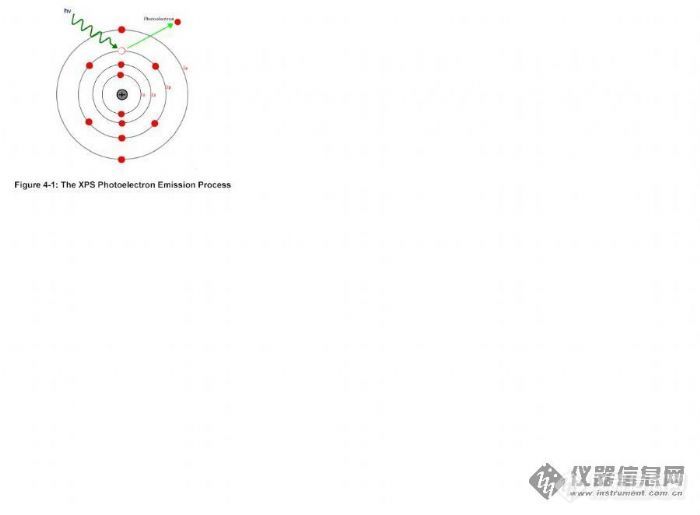XPS is an effective and widely used surface analysis technique, with which most UHV compatible samples can be studied. In an XPS experiment, a specimen is irradiated by low energy X-rays in an ultra high vacuum. This causes photo-ionisation of the atoms at the specimen's surface: photoelectrons are emitted from energy levels determined by the electronic structure of the specimen. The XPS analysis technique examines the kinetic energies of these photoelectrons to
determine their energy distribution. From the results of this analysis it is possible to infer which elements are present on the specimen, what their chemical states are, and in what quantities they are present.
Figure 4-1: The XPS Photoelectron Emission Process
Although X-rays can penetrate to a considerable depth in a sample only photoelectrons from the outer atomic layers of the sample surface are detected. This is because those from inner layers have a greater probability of colliding with other particles in the specimen before they escape from the surface, so that their kinetic energy is reduced to a level at which they contribute only to the background level of experimental data. Most of the photoelectrons still escape the specimen, but only those from the outermost layers contribute useful experimental information. XPS is therefore a true surface analysis technique.Low energy (soft) X-rays, usually derived from Al and Mg sources, are highly effective in XPS analysis. In principle, the X-rays cause photoelectrons of kinetic energy Ek to be emitted from the specimen, where Ek is related to the X-ray energy hνand electron inding energy Eb by the Einstein relation:
Ek = hν-Eb Equation 1
In practice the emission of photoelectrons is inhibited by the work function of the specimen. If the photoelectrons have enough kinetic energy they overcome the binding energy and the specimen work function. Photo-emission then occurs.The photoelectrons emitted are collected and their energies measured. The number of photoelectrons collected is plotted against energy to produce an energy spectrum.The kinetic energy of the photoelectrons is determined by the energy they possessed while still bound to their respective nuclei. Consequently their energy distribution
appears in the energy spectrum in discrete bands which reflect the quantized electronic structure of the atoms from which they came. The band structures in the energy spectra therefore show which elements are present in the specimen. Examples of XPS spectra are shown in Figure 4-2.
When several elements are present on the same surface they can be identified from the characteristic photoelectron binding energies reflected in an XPS spectrum.The chemical states of the elements can be determined from the same data. For the same element present in different oxidation states or molecular environments there is often a change in the binding energy of the electron shells (core-level binding energy).This is known as chemical shift, and various references exist which list this information as an aid to the identification of chemical states.The peaks observed in an XPS spectrum can be grouped into three broad categories:
• Peaks due to photoemission from core levels
• Peaks arising from valence levels, and
• Peaks due to X-ray induced Auger emission
Each atom on the surface of a material (except hydrogen), has electrons which are not directly involved in bonding. They are found in electron shells other than the outer(or valence) shell, and are termed core electrons.Valence electrons are those electrons, which are directly involved, in chemical bonding. They are found in an atom's outer electron shell and have very low binding
energies, typically less than 20eV. Their characteristics can be useful in differentiating between those elements that do not show significant chemical shifts in their core-level spectra. These valence structures can be determined by UPS.Atoms in a specimen become ionised as a result of photoelectron emission; in this state the atomic structure contains an excess of energy and will relax either by X-ray emission or by Auger electron emission. Auger electron emission is the dominant mechanism for light elements, whereas X-ray emission dominates for heavy elements. Each element produces a characteristic set of Auger peaks that indicate its presence.
![]()
![]()


